Yes..absolutely!!
7+ Shoes That Might Be Secretly Hurting Your Feet—And What to Wear Instead
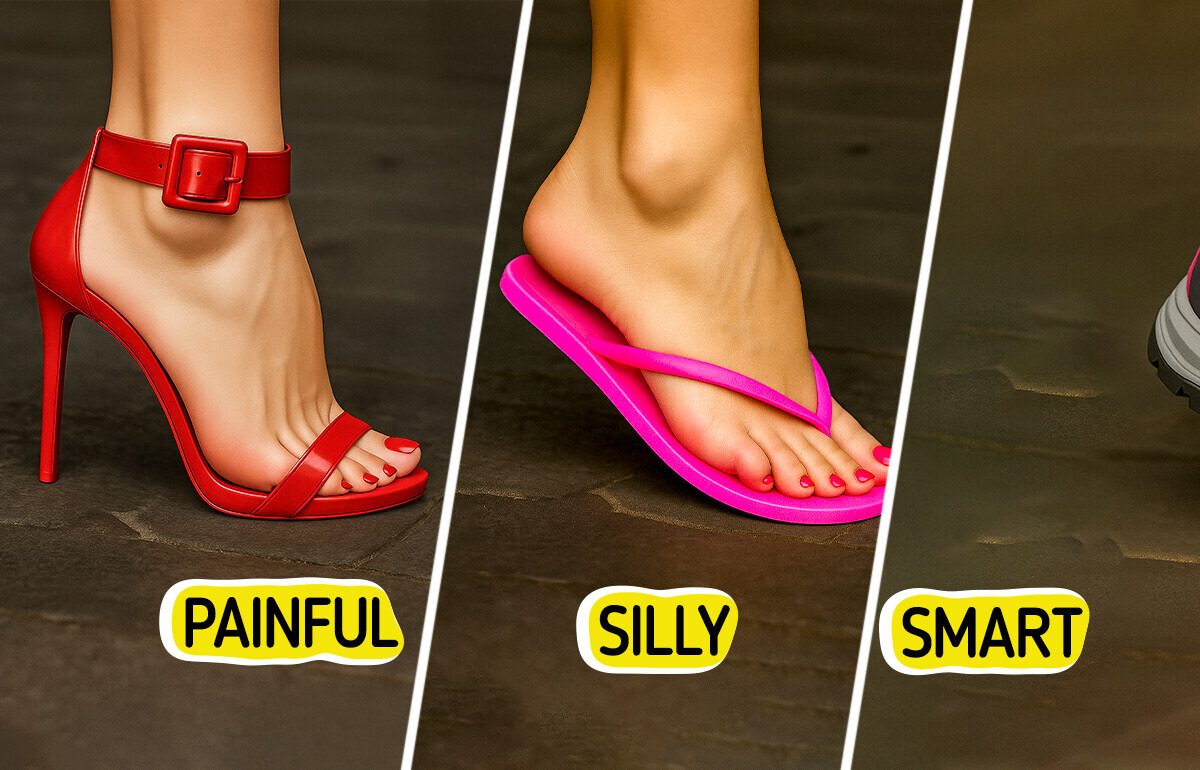
Shoes are supposed to make you feel good, adding flair to your style and comfort to your stride. Yet, what if some of your favorite pairs are secretly causing pain and discomfort? In this article, we’ll break down the top offenders that hurt your feet and suggest stylish, comfortable alternatives that will keep you feeling great all day. We’ll also explore how footwear can affect your health beyond just your feet, debunking the myth that comfortable shoes can’t be fashionable.
The sky-high stilettos & ultra-high heels
Sky-high stilettos and ultra-high heels offer glamour but at a steep cost to your foot health. They force the feet into an unnatural, downward angle, pushing most weight onto the balls of your feet. This immense pressure can cause severe foot pain, including metatarsalgia and hairline fractures.
Constant rubbing can lead to “pump bump” (medically known as Haglund’s deformity), while Achilles tendon shortening makes wearing flats painful. The instability also significantly increases ankle sprain risk. These are stylish choices, but often lead to real discomfort.
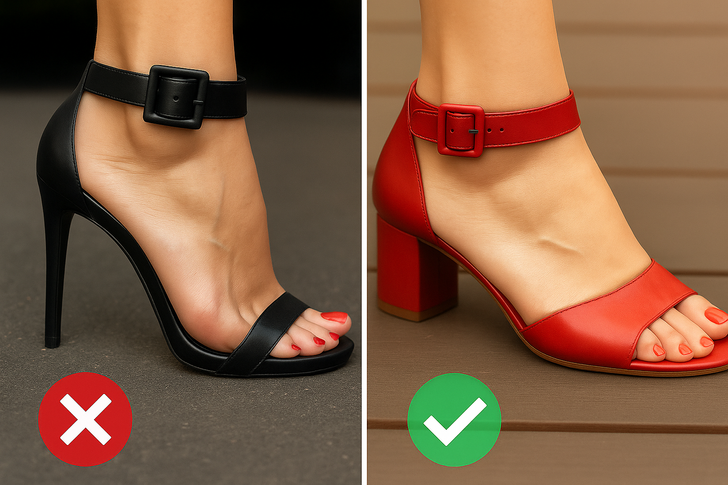
The good news is you don’t have to ditch elegance for pain-free shoes. When choosing dressier options, opt for lower, block heels (under 2 inches) which offer far better stability and distribute your weight more evenly. Wedges with good foot support can also be a more stable and comfortable alternative than thin heels.
For ultimate comfort in a dressier style, seek out “performance pumps” that blend athletic shoe technology with sophisticated designs, offering superior cushioning and support. These stylish, comfortable shoes prove that foot support and fashion can absolutely go together.
Ballet flats & flimsy flip-flops
The seemingly innocent ballet flats and flimsy flip-flops are secret saboteurs of your foot health. Their severe lack of arch support and cushioning means every step strains your feet, often causing excruciating heel pain (plantar fasciitis), Achilles tendinitis, and bone spurs.
This instability can also lead to cascading pain in knees, hips, and back. For flip-flops, the constant toe-gripping can even cause deformities like hammertoes, turning a casual choice into chronic discomfort.
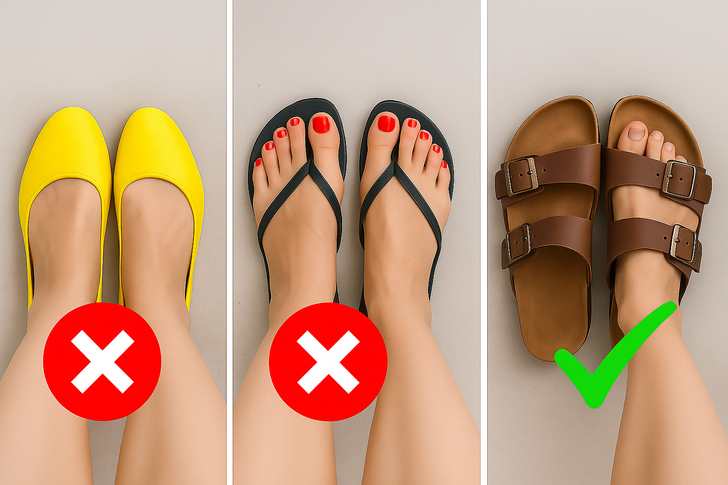
For pain-free shoes that still offer laid-back style, seek flats or sandals with built-in arch support and contoured footbeds. Many brands now combine fashion with essential foot support, creating truly comfortable flats and stylish sandals.
For extra needs, orthopedic shoes or quality orthotic inserts can turn moderate footwear into truly foot-friendly options. These footwear alternatives prove that foot health and chic style can easily go together.
The pointy-toed pinchers
Pointy-toed shoes, while undeniably chic, are notorious for their severe toe compression, squeezing the front of your foot into an unnatural shape. This immense pressure can lead to painful conditions like bunions, bony deformities at the base of the big toe, as well as corns and calluses from constant rubbing.
Over time, it can also cause hammertoes, where toes bend abnormally, and even nerve pain known as neuromas, a thickening of nerve tissue between the toes. This constant pinching not only causes immediate discomfort, but actively undermines your long-term foot health.
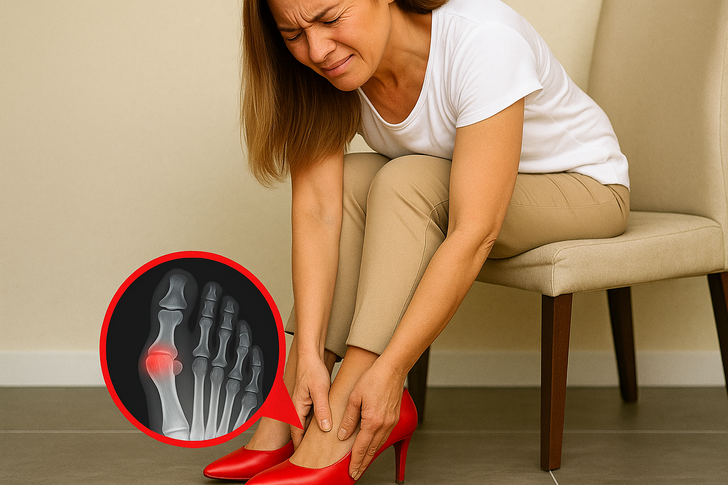
For pain-free shoes that still offer a sophisticated look, focus on a proper shoe fit. Opt for styles with wider, more accommodating toe boxes that allow your toes to splay naturally without compression. Look for shoes made from softer, flexible materials like genuine leather or pliable synthetics that can conform to your foot’s unique shape, offering better foot protection.
Almond or rounded toe shapes provide a more forgiving and comfortable fit, proving that stylish, comfortable shoes can easily maintain both elegance and vital foot support.
The stiff & flat canvas sneakers
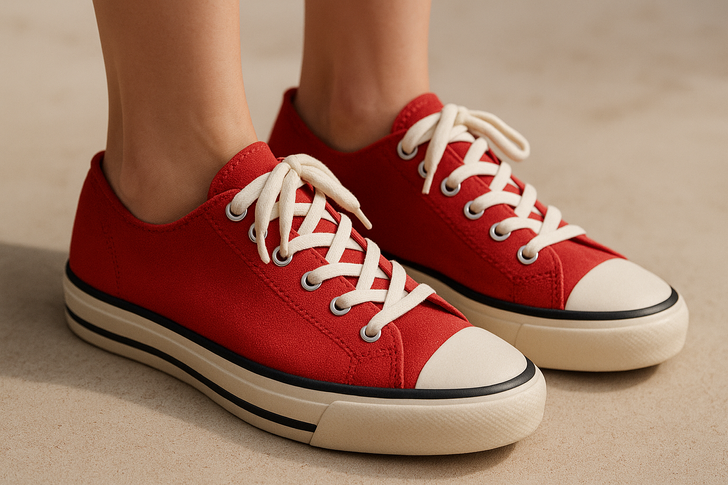
Those classic canvas sneakers sitting in your closet might seem like the epitome of casual comfort, but their minimalist design often comes at a significant cost to your foot health. These widely popular shoes typically offer little to no arch support or cushioning, leaving your feet vulnerable with every step.
Their rigid, flat soles prevent your foot from flexing naturally, a major contributor to common issues like chronic heel pain, tiny stress fractures in your foot bones, and various forms of tendinitis. Without proper shock absorption, every stride sends jarring forces up your legs, subtly turning a seemingly innocent choice into a hidden source of considerable discomfort.
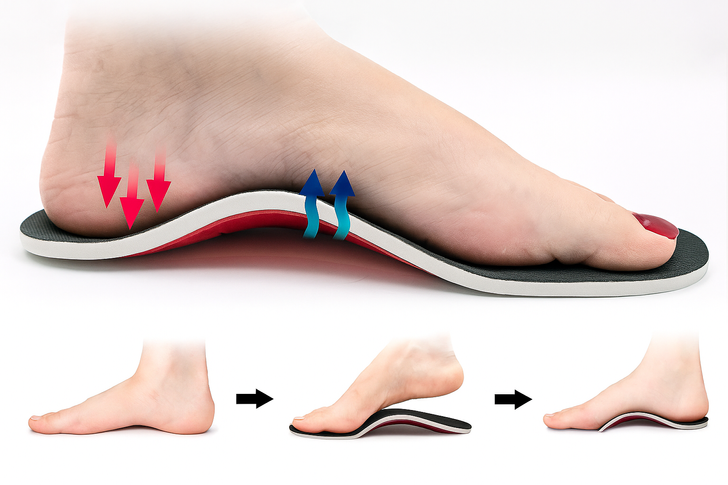
But here’s some good news: achieving pain-free shoes with a relaxed, stylish vibe is entirely possible. When seeking everyday footwear, prioritize foot-friendly sneakers specifically designed with essential foot support. Look for options that boast generous arch support, ample cushioning for superior shock absorption, and flexible soles that comfortably move with your foot’s natural stride.
If you love the casual aesthetic of flat sneakers but need more stability, simply consider adding supportive insoles or custom orthotics. These comfortable shoes prove you can easily find stylish alternatives that promote both effortless style and vital foot health.
The heavy platforms & wedges
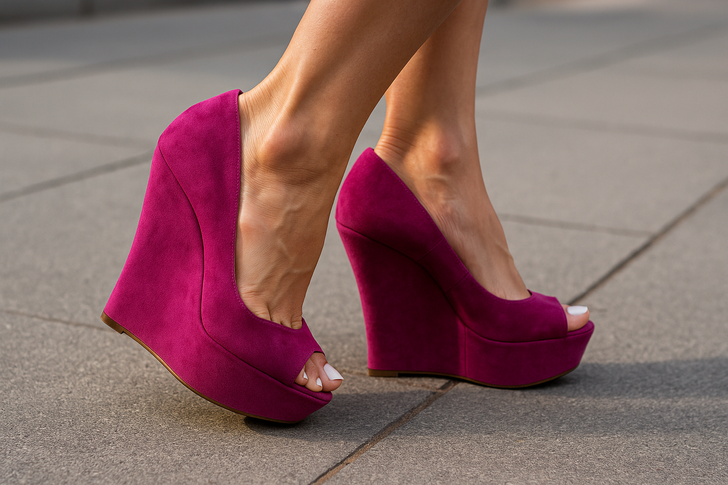
Heavy platforms and wedges promise extra height and a bold fashion statement, but their unique design can put an unexpected strain on your feet. Unlike flexible soles that allow your foot to move naturally, many of these shoes feature rigid footbeds that prevent proper foot flexion, placing undue pressure on the metatarsal bones at the ball of your foot.
If the heel is significantly higher than the platform, it still shifts your weight improperly, exacerbating foot pain. What’s more, their bulky construction can be cumbersome, increasing your risk of tripping and ankle twists, making them a less-than-ideal choice for all-day comfort and foot protection.
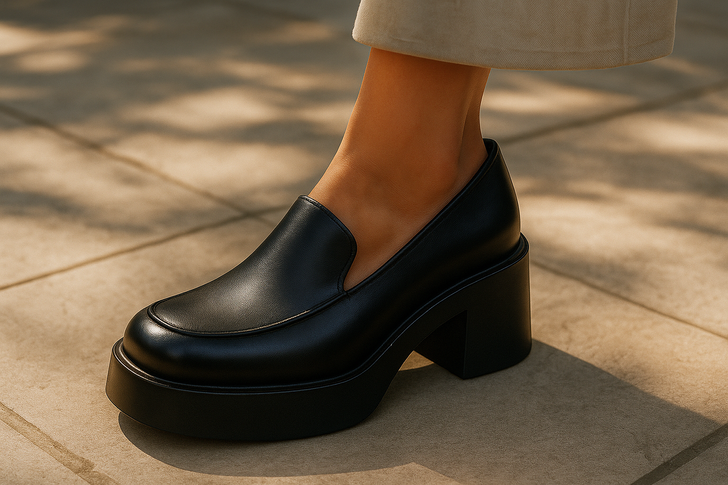
If you love the lift that platforms and wedges provide, prioritize options designed for pain-free shoes and better foot support. Look for platforms with a natural curve in the sole that allows for more fluid foot motion, rather than a completely flat, stiff base.
Lower and more flexible platforms, as well as flatforms (where the height is uniform from heel to toe) with good cushioning, can offer height without excessive strain. These footwear alternatives provide a more balanced distribution of weight, proving that you can still make a style statement while ensuring superior foot health and all-day comfort.
The rigid rain boots
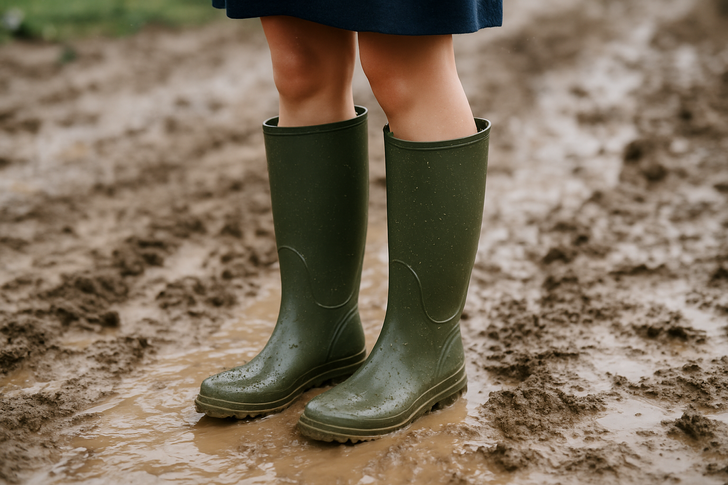
When the skies open up, rigid rain boots seem like your best friend, protecting you from puddles and mud. However, their practical design often conceals significant downsides for your foot health. Made from thick, non-breathable rubber, these boots effectively trap moisture inside, creating a warm, damp environment that’s perfect for fungal infections and even warts.
Beyond the dampness, many rain boots are ill-fitting—often too wide or inflexible—leading to uncomfortable rubbing, blisters, and an altered gait that can strain your feet and legs. With their typically minimal foot support, these boots are best reserved for short-term splashes, not all-day wear.
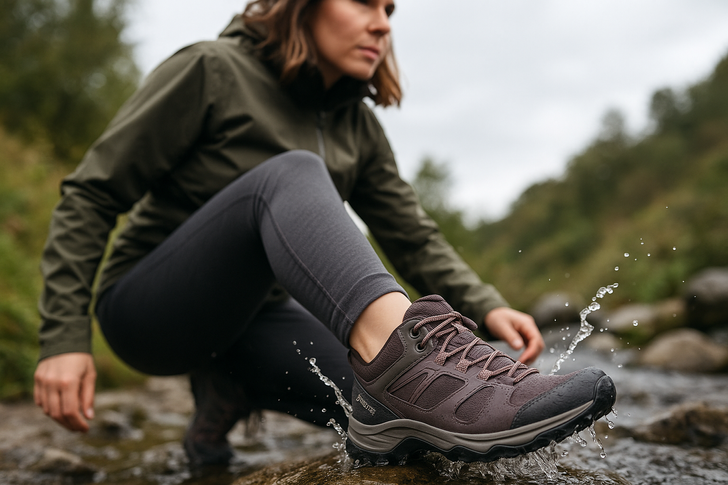
For truly pain-free shoes that stand up to wet weather, consider footwear alternatives designed for both protection and breathability. Opt for water-resistant shoes or boots featuring advanced breathable membranes (like Gore-Tex), which keep water out while allowing moisture vapor to escape.
Always couple them with moisture-wicking socks to prevent dampness and maintain optimal foot health. While dedicated rain boots have their place for heavy downpours, limiting their wear to necessary situations and choosing more supportive, breathable options for general wet-weather days is a smarter choice for long-term comfort.
Beyond the feet: How improper footwear impacts your entire body.
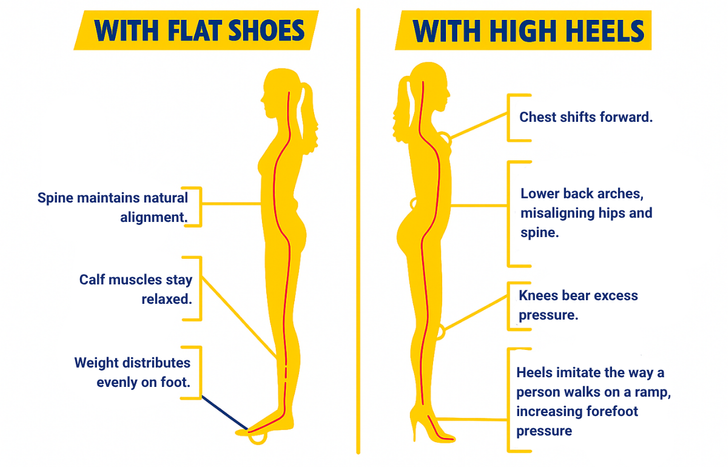
While we often focus on immediate foot pain, the truth is that the impact of improper footwear ripples far beyond your soles, affecting your entire musculoskeletal system. Here’s how ill-fitting shoes can secretly harm your body from the ground up:
- Misaligns Your Entire Body: Your feet are the crucial foundation of your body’s kinetic chain. When this foundation is unstable or misaligned—whether from the unnatural angle of high heels forcing your weight forward, or the complete lack of foot support in flimsy flats causing your arch to collapse—it throws your entire body out of alignment. This initial imbalance in your feet triggers a compensatory cascade, impacting how your entire leg and spine operate.
- Causes Joint Strain and Cascading Pain: This body-wide misalignment leads to persistent strain on various joints. The stress on your feet can alter your gait, placing undue pressure on your knees and straining hip muscles. You might experience unexplained pain in your ankles, knees, hips, and even your lower back, often without realizing your shoe choices are the underlying culprit.
- Leads to Long-Term Damage and Chronic Issues: Over time, this chronic, unnatural stress accelerates the wear and tear on your joints. This can significantly increase your risk of developing debilitating conditions like arthritis and other long-term mobility issues. Investing in proper foot health isn’t just about finding comfortable shoes for the day; it’s a vital investment in the longevity and overall well-being of your entire body.
How to choose the right shoes for foot health.
- Measure Your Feet Regularly: Your foot size can change throughout life due to age, weight fluctuations, and even pregnancy. Measure both feet, ideally in the evening, when they are slightly swollen from the day’s activity. Don’t just rely on your “usual size” as sizing can vary significantly between brands and styles.
- Understand Your Arch Type: Knowing whether you have high arches, neutral arches, or flat feet is crucial for selecting appropriate support:
High Arches: Often need shoes with generous cushioning and shock absorption in the midsole to compensate for the rigid foot structure. Look for shoes with a soft, flexible sole and midfoot cushioning.
Neutral Arches: Are the most versatile. You can typically wear a wide range of shoes, but still benefit from moderate arch support and balanced cushioning.
Flat Feet (Pronated Feet): Tend to overpronate (roll inward excessively). You generally need motion control shoes with firmer arch support and stability features to prevent overpronation and stabilize the foot. - The “Bend Test”: A well-constructed shoe should bend easily at the ball of the foot, where your toes naturally flex, but remain relatively rigid through the arch and heel. If the shoe bends too easily in the middle of the sole, it lacks proper support and should be avoided.
- Ample Toe Box Space: Stress the importance of enough room for your toes to wiggle and splay naturally, especially your longest toe. There should be about a thumb’s width of space between your longest toe and the end of the shoe. Avoid shoes that cram or pinch your toes, as this is a primary cause of bunions, hammertoes, and neuromas.
- Secure Heel Counter: The heel counter (the rigid part at the back of the shoe) should fit snugly without slipping or rubbing. A firm heel counter helps stabilize the foot and ankle, preventing excessive motion that can lead to pain.
- Material Matters: Prioritize breathable, flexible materials like genuine leather, suede, or mesh for the shoe’s upper. These materials conform to your foot shape, allow air circulation (reducing moisture buildup), and minimize rubbing that can cause blisters. Avoid stiff, synthetic materials that don’t stretch or breathe.
- Always Try On Both Shoes & Walk Around: Your feet are rarely identical. Always try on both shoes and walk around the store to ensure they feel comfortable and supportive. Pay attention to any pressure points or slipping.
- When to Consider Orthotics/Insoles:
Over-the-Counter (OTC) Insoles: These can provide extra cushioning and basic arch support for general comfort or mild issues. They are a good starting point for people needing a little more support than their shoes offer.
Custom Orthotics: If you experience persistent foot pain, have specific biomechanical issues (like severe pronation or high arches that need specific support), or chronic conditions, a podiatrist might recommend custom-molded orthotics. These are specifically designed to fit your feet and address your unique gait and structural needs, offering superior support and pain relief.
Choosing the right footwear is a crucial step towards preventing common foot ailments and ensuring overall body health. By understanding which shoe types pose risks and opting for supportive, well-fitting alternatives, you can significantly improve your comfort and well-being. For more practical tips on everyday health and surprising facts, you might also enjoy reading this article.
Comments
Related Reads
Top 7 Pedicure Trends That Are Taking Over Summer 2025
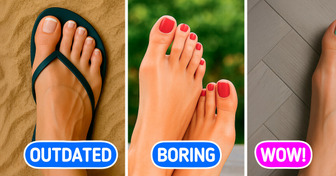
20 Times Kindness Won the Argument Without Saying a Word

12 Moments That Prove Kindness Still Matters in a World That Forgot How

I Refused to Split the Bill of Food I Didn’t Eat—I’m Not a Walking ATM

My Pregnant Roommate Tried to Kick Me Out—She Wasn’t Prepared for My Next Move
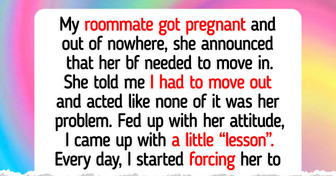
15 Times Romance Had Big Plans, but Real Life Wrote a Funnier Script

14 People Who Walked Straight Into Awkward Moments

15 Stories That Prove the Kindest Hearts Are the Strongest Survivors

12 Times Kindness Won Over Anger in the Best Way

I Refuse to Look Away After What My Stepson Did to My Son — It Destroyed Our Family

I Refuse to Be Forgotten After Raising My Stepson for 14 Years
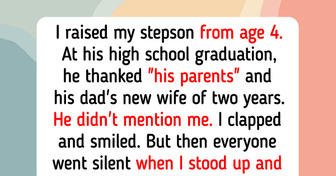
10 Moments That Remind Us Quiet Kindness Is Mightier Than It Seems
